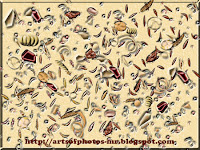Sand is a naturally occurring granular material composed of finely divided rock and mineral particles. The composition of sand is highly variable, depending on the local rock sources and conditions, but the most common constituent of sand in inland continental settings and non-tropical coastal settings is silica(silicon dioxide, or SiO2), usually in the form of quartz.
Please read more here.
Sand particle size range in diameter from 0.0625 mm to 2 mm
{Particle size, also called grain size, refers to the diameter of individual grains of sediment .This is different from the crystal-lite size, which is the size of a single crystal inside the particles or grains. A single grain can be composed of several crystals.}
The next smallest size class above sand is gravel, with particles ranging from 2 mm up to 64 mm. The next smallest size class is silt's particles smaller than 0.0625 mm down to 0.004 mm in diameter.
The composition of sand
The most common constituent of sand is silica (silicon dioxide, or SiO2) usually in the form of quartz, which is the most common mineral resistant to weathering { because of its chemical inertness and considerable hardness }
The composition of sand is variable and gives it its different colors .
Some sands contain magnetite, chlorite, glauconite or gypsum. Sands rich in magnetite are dark to black in color, as are sands derived from volcanic basalts and obsidian. Chlorite-glauconite bearing sands are typically green in color, as are sands derived from basaltic (lava) with a high olivine content. Many sands, especially those found extensively in Southern Europe, have iron impurities within the quartz crystals of the sand, giving a deep yellow color. Sand deposits in some areas contain garnets and other resistant minerals, including some small gemstones.
Uses of sand
MR
 |
| Sand with Photoshop |
Sand particle size range in diameter from 0.0625 mm to 2 mm
{Particle size, also called grain size, refers to the diameter of individual grains of sediment .This is different from the crystal-lite size, which is the size of a single crystal inside the particles or grains. A single grain can be composed of several crystals.}
The next smallest size class above sand is gravel, with particles ranging from 2 mm up to 64 mm. The next smallest size class is silt's particles smaller than 0.0625 mm down to 0.004 mm in diameter.
The composition of sand
The most common constituent of sand is silica (silicon dioxide, or SiO2) usually in the form of quartz, which is the most common mineral resistant to weathering { because of its chemical inertness and considerable hardness }
The composition of sand is variable and gives it its different colors .
Some sands contain magnetite, chlorite, glauconite or gypsum. Sands rich in magnetite are dark to black in color, as are sands derived from volcanic basalts and obsidian. Chlorite-glauconite bearing sands are typically green in color, as are sands derived from basaltic (lava) with a high olivine content. Many sands, especially those found extensively in Southern Europe, have iron impurities within the quartz crystals of the sand, giving a deep yellow color. Sand deposits in some areas contain garnets and other resistant minerals, including some small gemstones.
Uses of sand
- Agriculture: Sandy soils are ideal for crops such as watermelons, peaches, and peanuts.
- Aquaria : Sand makes a low cost aquarium base material which some believe is better than gravel for home use.
- Beach nourishment : Governments move sand to beaches where tides, storms cause changes to the shoreline eroding the original sand.
- Brick : Manufacturing plants add sand to a mixture of clay and other materials for manufacturing bricks.
- Mortar : Sand is mixed with cement and sometimes lime to be used in masonry construction.
- Glass : Sand is the principal component in common glass.
- Many other things like paints, roads, abrasive in cleaning, preparing, and polishing.
The Photoshop
I had designed the upper artwork with Photoshop
HOW TO DESIGN IT ?
- Open new Photoshop document with the size you like,select the background color.
- Add style to it from the style panel ( I had selected snow )
- With the custom shape tool add the shapes, and style you like.
- Add layer style to the shape . Apply what in the pictures.
- Use the transform to re-size or re-shape the shapes .
- Save your work .



No comments:
Post a Comment
Thanks.